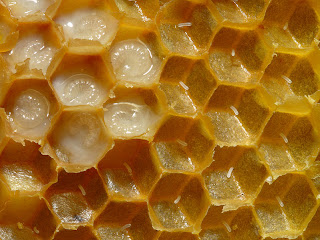Today we went up to our hives, so that we could feed the hives that are there and install our newly acquired hive. The flowers around here have passed, and as winter comes there is a drop in food sources for the bees. Because of this, we use some sugar-water in frame-feeders for the bees. Frame-feeders are the same shape as a comb-frame, but hold the sugar water. As you will see from the pictures, the environment can get harsh. Though sometimes there are horses and orchards nearby, so the bees can get water from the horse watering troughs and visit the orchards for pollen and nectar - food. The pictures should make things more clear.

This is the truck with the new hive. It's supposed to be CLOSED, however the bees somehow pushed up the screen, and boy was that a comedy! Looking a bit like Pig Pen, Charlie Brown's friend. Luckily the truck was on our 'campus', where we program but do not actually have any access to the public - strictly staff here in the hills. We just keep equipment, and bees, of course.

Here you can see the bees 'bearding' on the new hive that is going to be installed. Closer to the camera are 'feeder frames' which will hold sugar water in the hive for the bees to munch on.... yum!

This is Kurt, Executive Director of the Boojum Institute and generational beekeeper.

Here you can see our property. We are very lucky to have so much room for the Boojum's Beeyard..

Filling the Feeder Trays with sugar water.

Taking a feeder frame OUT of our new hive. It was empty, left in there who knows when.

Here we are smoking our new bees, just off screen, to the right. On the left are some comb filled frames ready for action!

Very nice comb! You can see the bees have drawn comb along the bottom of the frame - and you can see nice brood cells and pollen towards the bottom.


Looking for the queen, we just didn't see her. However there are lots of eggs and brood and they are smack in the center so the queen seems healthy.
The bees are way too busy to even notice us!


Putting the frames, one by one, into the boxes.
Slipping bits of loose comb we had cut off the frames, because we want to give the bees all their stores and brood back. Now they can really take over the new hive! We will come back later to clean the hive up a bit.

Here we are stripping the loose comb off the old box, to also put into the new box. Notice that throughout all this Kurt is using his bare hands, AND wearing shorts! However he knows this hive is tame, and he has many years of experience.
Finally, with the lid back on, we left a little ramp for the bees that had spilled while shaking them into their new home. This will help them find the entrance. We could see bees leaving scent at the entrance, which will attract their new friends. We also closed much of the entrance with some roofing tile that was left on the property, so the bees have less to defend.

































